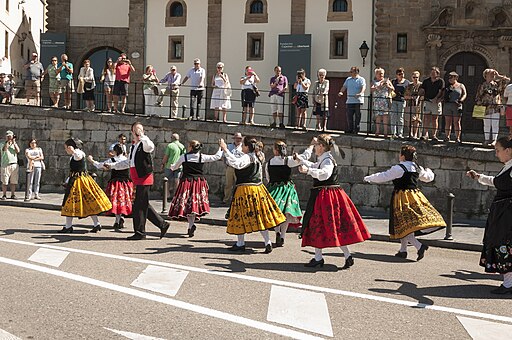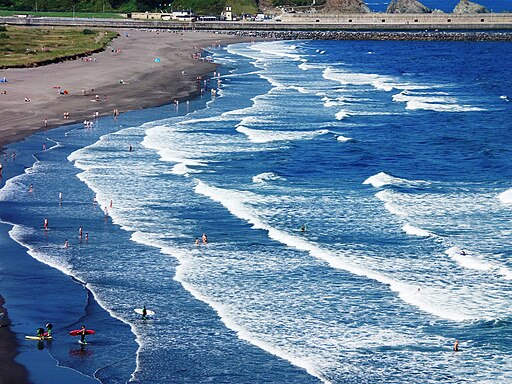Culture, Travel & Weather
Culture – Camino del Norte
Asturias boasts a rich and diverse culture that reflects its unique history.
The region is known for its traditional cider production, bagpipes music, and festivals such as the famous “Descenso del Sella” held annually in August.

Asturias’ cuisine is particularly notable for its seafood dishes, with fresh fish from the Cantabrian Sea playing an important role in local diets.
Likewise, Asturias’ cultural heritage can be seen in its architecture with many pre-Romanesque churches that have been preserved to this day.
Finally, the region has strong roots in mining and industry which has helped shape its identity over time.
As a result of these factors working together, Asturias possesses a distinctive atmosphere that sets it apart from other regions of Spain.
Gastromony
Asturias is famous for its gastronomy, which reflects the region’s mountainous landscape, verdant meadows and coastal villages.
The sea offers an abundance of seafood such as lobster, squid and sea urchin, while the pasturelands are home to grazing cows producing high-quality milk used to make cheese and butter.
Asturian cider is also a well-known product made throughout the region.
Additionally, Asturia boasts unique dishes such as fabada asturiana, a hearty stew with bean broth and meats including chorizo and morcilla (a type of sausage), along with cachopo – breaded veal or beef steak stuffed with ham and cheese.
Visitors can enjoy authentic fare at restaurants specializing in local cuisine or visit food markets to purchase fresh ingredients for cooking their own traditional dishes at home.
Overall, Asturia’s gastronomic offerings are not only delicious but also demonstrate a deep appreciation for local ingredients that embody the essence of this mountainous northern Spanish region.
Outdoor activities/Sports
Asturias offers several outdoor activities for sports enthusiasts.
Thanks to its rugged terrain and mild climate, Asturias is known for hiking, cycling, rock climbing, surfing, and other water sports.
The Picos de Europa mountain range provides excellent hiking trails with beautiful views of the small towns located around the area.
Cycling is also popular among locals and tourists alike, as there are several bike rental shops scattered across the region to cater to different skill levels.
For those looking for a thrill, La Isla beach in Colunga and Playa de San Lorenzo beach in Gijón offer perfect conditions for surfing all year round.
Additionally, fishing and canoeing are some other popular sports enjoyed along Asturia’s rivers such as Sella and Narcea.
In summary, outdoor activities in Asturias provide an adventurous experience with options suited to everyone’s interests and preferences.
Airports & Ferries
Map, airports – Aviles, Santander and La Coruña, Bilbao. Ferry – Santander and Bilbao.
Asturias has multiple airports that serve both domestic and international flights.
Asturias Airport is the primary hub for the region, located only 14 kilometers from Avilés city center and offering numerous daily flights to destinations throughout Europe. With its modern facilities and amenities including restaurants, shops, car rentals, and shuttle services, it provides travelers with a seamless experience.

Additionally, ferries serve as an alternate mode of transportation for getting around the coastal region. The Port of Gijón and Port of Avilés offer transport to various locations within Spain such as Santander and Bilbao.
Both ports feature convenient amenities like parking areas with easy access to ticket purchasing booths making it quick and hassle-free for travellers heading out on their next adventure or returning back home.
Weather – coastal and mountain
Asturias, located in the north of Spain, is characterized by a temperate oceanic climate.
The region’s proximity to the Atlantic Ocean brings moderate temperatures throughout the year with an average temperature of 16°C.
Winters in Asturias are typically mild, with temperatures ranging from 7°C to 13°C and occasional rainfall or snowfall in mountainous areas.
Spring and autumn are considered to be the best seasons to visit Asturias as they have plenty of sunshine, low humidity levels, and temperatures ranging from 12°C to 19°C.
Summers tend to be cooler compared to other regions around Spain with moderate temperatures between 18°C – 25°C.
However, during rainy periods known as “Renas”, which can occur at any time of year but mostly fall between October and March, Asturias often experiences high levels of precipitation leading to flooding and disruption in transportation networks.
It is worth noting that due to its location near the Bay of Biscay on the Cantabrian Sea (Gulf of Vizcaya), dense fog can also form, particularly during certain times of the year, making driving conditions particularly challenging for motorists visiting Asturias.




